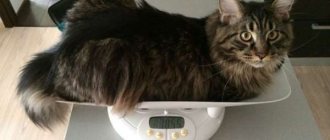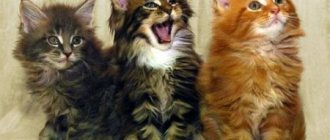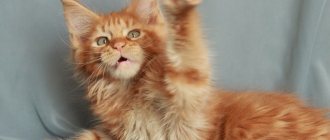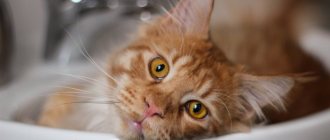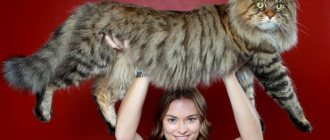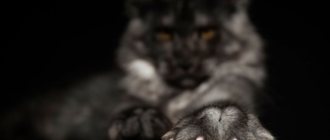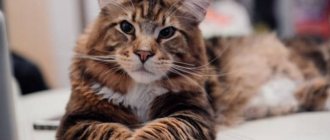Adult Maine Coons are famous for their large size and considerable weight for a domestic cat. And many people who have only recently become owners of babies of this breed are perplexed when looking at their funny, playful and still very small pet. Will he, too, someday turn into a huge, important and at the same time graceful cat? How do kittens grow and what factors can influence the size they eventually reach when they finally become adults?
Factors influencing growth
- Floor. Boy kittens grow faster than girl kittens and, as a result, when they finally mature, they reach larger sizes than their sisters.
- Genetics. Kittens from large parents are born with greater body weight and, as a rule, also grow up to be as large as their relatives.
- Physical condition of the newborn. Babies born weaker gain weight less quickly.
- Large litter size. Kittens from small litters are born larger than kittens from larger litters.
- Maintenance of mother kittens during pregnancy and while feeding offspring. If a mother cat eats properly and is kept in good conditions, then she produces healthy and strong offspring, which is the key to good growth and weight gain in babies.
- Stress. If there is a turbulent atmosphere in the house where the pet is growing up, if the owners are arguing, starting renovations, or something else is happening in their family that disrupts the usual rhythm of life in the house, then the kitten will gain weight worse due to strong worries.
- Past illnesses. Kittens that have recovered from the disease grow worse, and their growth may stop altogether for some time.
- Feeding. In order for a pet to grow well, it must eat properly and nutritiously.
Heredity depends not only on the mother of the kittens, but also on the father, so from different cats the same cat can produce offspring of different sizes.
Origin story
Basic information about these amazing cats was obtained a little over a hundred years ago, and the first photo appeared in 1895. The Maine Coon is an American cat from Maine.
Breeders and geneticists did not work on it. Large, dexterous and very smart - they are the result of natural selection that took place in a northern state with a harsh climate.
This is how the big Maine Coon cats appeared, photos of which depict tenacious, energetic predators.
Their natural origin explains their endurance, strength, health and wild colors, which are necessary for the predator to camouflage during the hunt.
The word “Coon” in the name of the breed comes from the English raccoon (raccoon), which is why they are often called raccoon cats. The cats received this nickname because of their long raccoon-like tail and friendliness towards people.
There is a version about the origin of Maine Coons from mixed breeds of cats and raccoons, but the theory has been refuted. However, felinologists were unable to determine the ancestors of these cats.
The story goes that in 1993, the British Isle of Man issued 25 pence coins depicting fluffy, long-tailed Maine Coons.
Video
Video from the exhibition, breeder's opinion.
Below are photos of the kitten's development by month.
5 weeks.
1.5 months.
2 months.
3.5 months.
5 months.
7 months.
10 months.
11 months.
1 year and 2 months.
Record holders
According to the Guinness Book of Records, the longest cat is the Maine Coon Stewie, whose full name is Stuart Gilligan. Its length was 123 cm. The record was set in the USA on August 28, 2010. Stewie died in 2013. The current record holder for length is another Maine Coon cat named Ludo, whose length is 118.33 cm.
Kitten development
During its maturation, a growing kitten goes through four stages of growth:
- Neonatal period. This is also the period of the newborn. It usually lasts 4 days. During this time, the daily weight gain of the cat's cubs depends on how easy their mother's birth was.
- Suction period. Lasts 1 month. During this time, kittens, on average, gain from 20 to 50 grams of weight daily.
- Transition period. It begins from the time the cat cubs begin to eat a little on their own and continues until about one and a half to two months (7-8 weeks of life). At this time, the rate of weight gain slows down somewhat.
- After the suckling period. The kittens are weaned from their mother, the cat, and feed completely on their own. They begin to gain weight and height again quite quickly. This stage lasts from approximately one and a half months until the little Maine Coon becomes a full adult.
Cats of this breed mature and gain weight until about the age of three.
They also grow up to the age of 3 years. It is during this period that physiological and psychological maturation occurs, as well as puberty. For about another year or two the cat will continue to “matrate.” Muscle mass will increase, he may gain a little weight, and his chest will expand. At the age of 4–5 years they are active and full of energy.
Features of the breed's exterior
The exterior of the Maine Coon is unique; there are no exact analogues of such a cat anywhere in the world (see the largest Maine Coon in the world).
Description of the Maine Coon breed:
- The body is elongated and large. The neck and chest are wide.
- The tail is approximately equal to the length of the body.
- The head is large, high-set ears with tufts at the tips, a sharp convex chin, narrow, relatively small “live” eyes (compared to the large head).
- The eyes are located close to each other on a wide muzzle. Some lovers of the breed jokingly call the face of these cats a “felt boot face,” since the nose and jaw are noticeably pushed forward from the base of the head.
- The eye color is predominantly golden. Sometimes greenish, amber, light orange, or yellowish colors are found, extremely rarely - blue or light blue.
- The coat is thick, long, growing along the body.
- The areas of the body with the longest hair are the back, belly, and sides of the hind legs. Short hair grows mainly on the head, neck, and shoulders.
Mass table by month
| Kitten age | Cat weight (in grams) | Cat weight (in grams) |
| 1 month | 630 - 750 g | 560 - 680 g |
| 2 months | 1230 - 1500 g | 1150 - 1400 g |
| 3 | 1800 - 2300 g | 1700 - 2300 g |
| 4 | 3000 - 3800 g | 2700 - 3600 g |
| 5 months | 3200 - 5500 g | 2900 - 3900 g |
| 6 | 3900 - 6500 g | 3200 - 4000 g |
| 7 | 4200 - 6500 g | 3500 - 4300 g |
| 8 | 4500 - 6900 g | 3800 - 4300 g |
| 9 | 5000 - 7000 g | 4100 - 5000 g |
| 10 | 5200 - 7500 g | 4200 - 5500 g |
| 11 | 5700 - 8000 g | 4300 - 6000 g |
| 1 year | 5700 - 9000 g | 4500 - 6300 g |
| 1.5 years | 6000 - 9500 g | 4500 - 6500 g |
| 2 years | up to 10,000 g | 4500 - 7000 g |
| 2,5 | up to 12,000 g* | 4500 - 7200 g |
| 3 | up to 13,000 g* | up to 7500 g |
* Up to 12,000 - 13,000 g - the weight of adult castrated cats.
Size standards and maximum weight
These animals are rightfully considered the largest domestic cats among those breeds that are able to live with humans without any problems. All four-legged champions and record holders for weight and height are Maine Coons. They have significantly outgrown the rest of their competitors. The average weight of representatives of this breed is 8-10 kg for males and 4-7 kg for females.
Like other native species, big Manx cats mature late. They enter a sexually mature state quite quickly - females can give birth to offspring already at the age of 7-9 months, but Maine Coons grow up to 4-5 years.
At the age of 5 years, the weight of a Maine Coon cat remains almost unchanged. As soon as a pet loses its appetite, loses weight and becomes lethargic (even in the absence of other signs of illness), it needs to be shown to a veterinarian in order to exclude the development of diseases, which often pass in a latent chronic form, but necessarily manifest themselves in later stages.
This is interesting! A cat named Omar became a contender for entry into the Guinness Book of Records. By the end of the first year of his life, he had already gained 10 kg, and later each year he added one more. Now the title candidate is 4 years old, the actual body length of this Maine Coon is 1.2 meters and, standing on his hind legs, he can easily take food from the dinner table.
What to do if the kitten is not gaining weight?
If the kitten has stopped gaining weight, first of all, you need to find out the reason why this is happening. If a slight weight gain is associated with improper feeding (possibly from the breeder), then the new owner of the furry baby needs to take the following measures:
- Add more high-calorie foods to your pet's food, and also increase the amount of animal proteins.
- If your pet eats ready-made food, then you can try to switch it to food richer in proteins and higher in calories, preferably of a better class than the previous one.
- Start giving your pet vitamin and mineral supplements (preferably complex ones, which contain the entire necessary set of microelements).
Without consulting a veterinarian, you should not give your kitten biologically active additives to increase appetite or, especially, drugs that artificially increase body weight.
Also, in all cases, if a kitten’s poor weight gain is not related to nutrition, but to reasons other than genetic, it makes sense to take the pet to a veterinary clinic for a consultation and examination.
How to raise a furry giant?
The weight and developmental characteristics of the Maine Coon are determined by a number of circumstances. Some of them depend only on Mother Nature, others can be influenced by the person caring for the kittens.
What influences the development of the baby coon?
- Gender of the kitten. Small cats are born larger than their sisters and gain weight faster.
- Weight and dimensions of the mother cat. The larger the mother, the larger her kittens are at birth and the faster they develop.
- Condition of the kitten at birth and in infancy. If a baby baby was born weak and prone to illness, it will grow slower than its brothers and will weigh less than them. But this circumstance does not prevent the smallest kittens in the litter from turning into huge cats weighing 10 kilograms.
- Number of kittens in the litter. The more kittens are born, the less each of them weighs compared to kittens from a small litter.
- Genetics. The length, weight and overall development of a kitten are influenced not only by maternal genes, but also by the heredity of the father. Therefore, kittens of the same cat, born from different cats, may differ in size at birth, and subsequently in the speed of development.
- Nutrition for a nursing mother. The more complete and varied the diet of a mother cat, the healthier and larger her kittens will be.
- Conditions for keeping a nursing cat family.
- Stressful situations. Any disturbances (noise, presence of other animals, change of place of residence) can affect the development of kittens. A stressed female may stop feeding her offspring, which leads to a change in the diet of growing animals, causing them to gain weight more slowly. A hormonal surge during stress also leads to the same consequences, and this applies to both cats and kittens.
Natural nutrition table by month
| Kitten age | Authorized products | Daily Recommended Value |
| 1 month | - mother's milk - liquid porridge with milk | Six times a day |
| 1.5 - 2 months | - mother's milk - ready-made milk formula for kittens - liquid porridge with milk - scraped meat, scalded with boiling water, but not boiled | Six per day, approximately 120 - 150 grams per day |
| 3 – 6 months | - ready-made milk formula for kittens - liquid porridge with milk - thin meat puree - scraped meat, scalded with boiling water, but not boiled | Four times a day, approximately 190 - 245 grams per day |
| 6 – 9 months | - liquid porridge with milk — dairy products: kefir, milk, sour cream - thin meat puree - low-fat natural cottage cheese - yolk (boiled or raw) - lean meats | Three times a day, approximately 200 - 250 grams per day. |
| 10 - 12 months | — dairy products: milk, kefir, fermented baked milk, low-fat natural yogurt, sour cream, cheese - thin meat puree - liquid porridge with milk - vegetables - boiled fish - low-fat natural cottage cheese - eggs (white - only boiled, yolk can be given raw) - lean meats | Twice a day, approximately 150 - 200 grams per day |
What should you consider when choosing a kitten?
A real, purebred Maine Coon kitten is not cheap, and therefore it is worth taking the choice seriously, so as not to be deceived and not to buy a crossbreed, there is a lot to consider.
It is best, of course, to take a pet from professionals with documents and a contract, but even if you decide to take a kitten simply from the hands of amateurs, then you should do the following:
- Draw up a contract and print it out;
- Ask the seller to sign the contract;
- Look at the kitten's parents;
- Define metrics;
- Examine the kitten for signs of disease;
- A true Maine Coon is not shy or aggressive;
- A Maine Coon kitten at 4 months is 5 times larger than a regular kitten!
- A true purebred Maine Coon has thick, long, dense and fluffy fur;
- They have a wide, long nose with a large jaw;
- The tail of a purebred Maine Coon is always longer than the spine;
- Maine Coons are very calm, they never climb into corners, under sofas or hide.
Important: A cross with another breed will be very noticeable by 4 months, so you should not adopt a kitten earlier.
Feeding kittens with prepared food
Feeding your pet prepared food has many benefits. In particular, it makes it easier to choose the right diet and relieves the owner of the need to prepare food for the cat. However, the following recommendations must be observed:
- The food should be appropriate for the age of the kitten and, if possible, the breed.
- It must be of high quality - no lower than premium class.
- For the first time after arriving in a new home, the kitten should eat the same as in the breeder’s home. If he ate ready-made food, then you need to try to find exactly the same one and feed the baby with it.
- Transfer to another food can begin after the period of adaptation to the new home has been successfully completed. At the same time, you cannot immediately transfer the Maine Coon to a new food; the transition should be carried out gradually.
- You cannot combine feeding with prepared food and natural food. The kitten must eat one or the other.
- Up to 1.5 years of age, the pet can be fed with dry food for kittens; later, it is recommended to switch the Maine Coon to food designed for adult animals.
It is necessary to strictly follow the daily quantity and serving size recommended by the food manufacturer.
Popular Maine Coon colors
Colors based on primary colors are black (also known as black marbled), red (or its common name is red), cream and blue Maine Coon (common name is grey). However, solid colors are rare in these cats, and they usually have a brindle pattern or spots.
Based on this, all Maine Coon colors are usually divided into four categories:
- Solid (from the English solid) – solid color;
- Tabby (from English tabby) – striped color;
- Smoky;
- Tortoiseshell spotted.
The classic tabby (also known as marbled tabby) is characterized by wide spiral stripes that are located on the sides of the animal. Sometimes these stripes are very similar to marble stains. Very common are Maine Coons with the brindle tabby color, which got its name because it resembles the color of a tiger - the stripes are located vertically and parallel to each other. Some cats have a ticked tabby, a color in which there are no stripes or spots on the skin, but there is a pattern on the animal's face, or on its chest or paws.
The smoky color in its visible appearance resembles creeping smoke. The hair may be gray or even distinctly white at the roots, but the ends may be blue or black. This color looks very beautiful, especially when the animal is moving, when the movement of the fur creates a shimmering effect. Only cats have a tortoiseshell color, that is, with multi-colored spots, since cats cannot have more than two colors with very rare exceptions due to genetics.
Complications from overeating
Overeating is not good for your cat. It leads to obesity and related diseases. An overfed pet may develop heart, liver, lung, stomach or intestinal diseases. Diseases of the musculoskeletal system may also appear, which negatively affects the activity and general well-being of the cat. Overeating and excessive weight gain contribute to the likelihood of developing cardiomyopathy, dysplasia or spinal muscular dystrophy, to which representatives of this breed may already be predisposed.
The maximum weight that a healthy, non-obese and uncastrated cat can have is 10 kg.
No artificial records
Most often, a weight of over 10 kilograms is observed in “artificial” cats: their diet contained a lot of dietary supplements, which caused metabolic disorders. Under no circumstances should you believe the myths about cats weighing 20 kilograms and chasing weight “records” - this is a sure path to illness and premature death of the animal.
Maine Coons should not be overfed: excess weight provokes diseases of the heart, lungs, internal organs and joints. Representatives of this cat breed are distinguished by good health and endurance, but they also have an innate tendency to cardiomyopathy, spinal muscular atrophy, and hip dysplasia. Excess weight increases the likelihood of developing these difficult-to-treat ailments.
Useful tips and tricks
If you have a small Maine Coon and are monitoring its proper development, then you should listen to some useful tips.
- Do not give Maine Coon kittens dietary supplements or medicated foods without consulting your veterinarian first. Any drugs or means to increase body weight taken without a specialist's indications can seriously harm these animals.
- If you feed your Maine Coon with special ready-made food, then you must give it in the quantities and sizes specified by the manufacturer.
- Don't overfeed your Maine Coon to help it grow faster. Such actions, of course, will lead to weight gain, but these will be unhealthy changes. The animal may suffer from obesity, and this is a serious problem for its health.
- It is advisable to keep the maximum weight of an adult Maine Coon within 11-13 kg, no more.
- Choose only high-quality food for your pets with plenty of vitamins and other nutrients. Without proper nutrition, the Maine Coon will not grow as it should.
